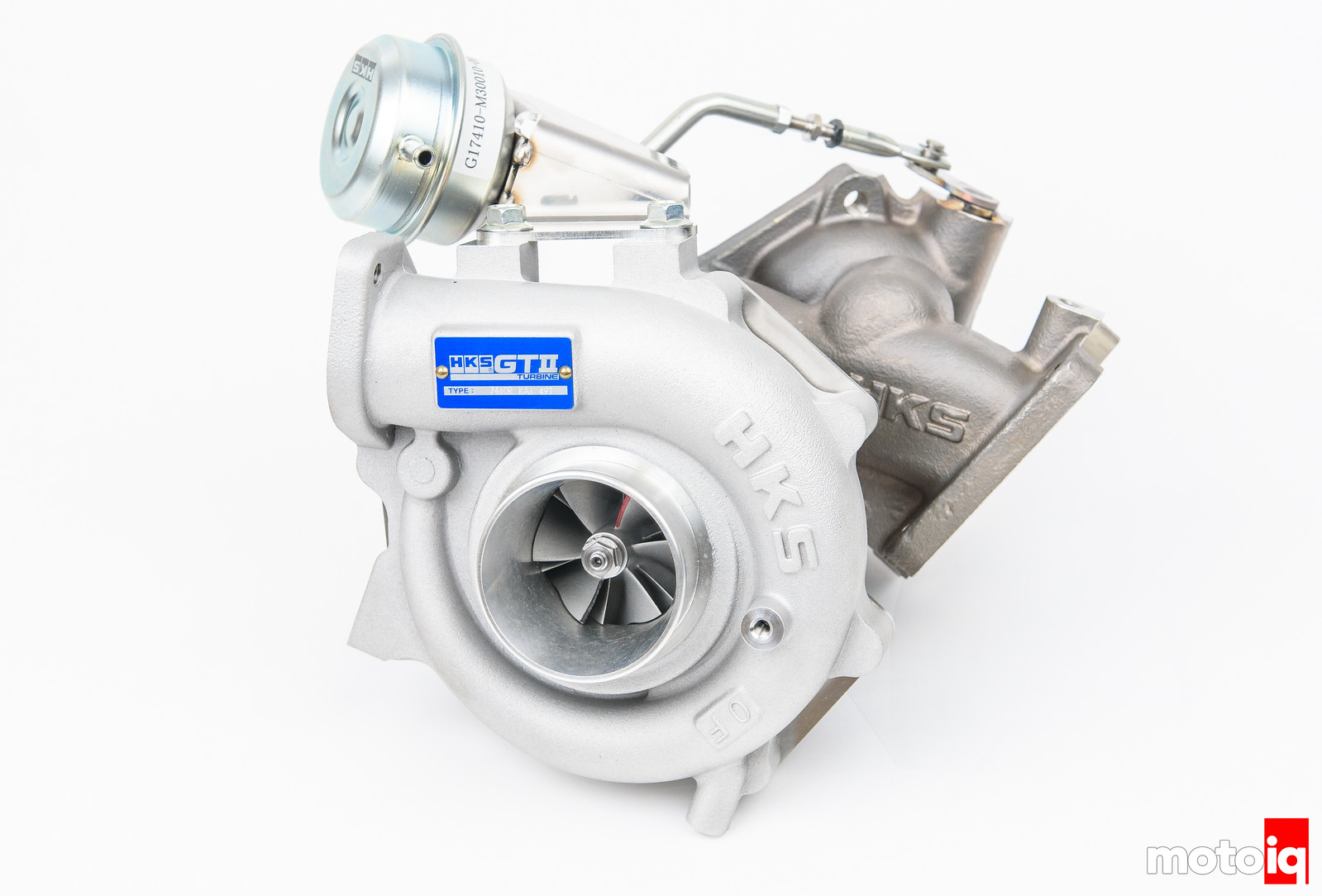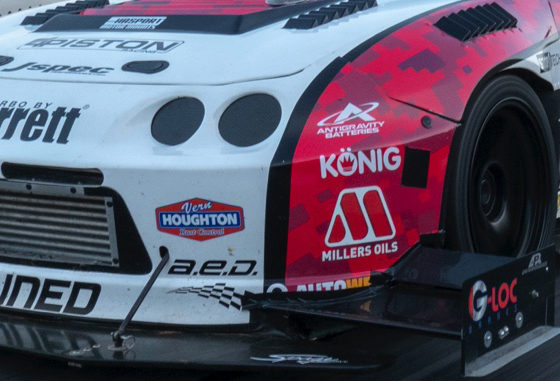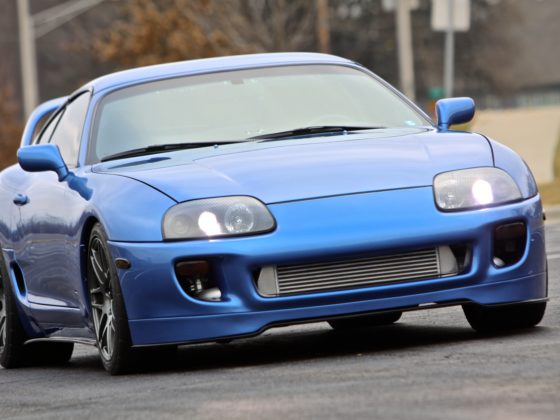
Since we plan on using the Link ECU to run flex fuel, we needed to run much larger injectors. We turned to DeatschWerks for a set of vehicle-specific high impedance 1500cc per minute injectors. With high impedance, we need to disconnect and bypass the OEM resistor box. Other than that, the injectors drop right in.
The DeatschWerks injectors are characterized and come with a flow chart showing the flow data at 450 points. This is a great help for tuning. The injectors come in flow-matched sets that are dynamically flowed and matched and a low pulse width range, a transitional range, a linear range, and wide open static flow. This is stuff that was previously only done by a few companies on expensive injectors. Typically if injectors are sold as flow-matched sets they are only matched at wide open static flow, not the other flow states that make up a large part of and injectors driveability and response.
With 1500cc/min of flow, our new injectors should serve us well with some headspace for ethanol and possibly more mods later.

To handle the greater fuel flow needed from running ethanol, we turned to AEM Electronics for one of their universal high-capacity fuel pressure regulators. The high-capacity regulator has a longer spring to provide a wider adjustment range (from 40 to 130 psi) than their standard regulator. It has a 1:1 boost referenced rising pressure rate and unlike the standard AEM regulator the high-capacity regulator has a single large return orifice. AEM’s regulator is alcohol compatible so it will get along with our flex-fuel plans.

With our plans for E85 goodness, we had to up our fuel pump capacity from our current 255 liters per hour to our new DeatschWerks DW300 pump with a 340 liter per hour flow rating. We got DeatschWerks’ application specific configuration DW300 that will drop right into our Evo.
The DW300 has carbon commutators and a fully sealed and encapsulated armature for ethanol compatibility. TheDW300 pump has a high torque low amp motor has less stress on the OEM wiring, runs cooler and heats the fuel less.
Stay tuned as we will start installing our parts and doing the necessary wiring and fabrication to get everything working cleanly together!
Sources
Hypertune
HKS USA
DeatschWerks
AEM Electronics




17 comments
You mentioned that your experience is turbos liking a bigger plenum, but how big do you aim for? Is there such a thing as too big?
A good rule of thumb is 1.5 times the engine displacement. Too big results in poor throttle response and lag.
Great, thanks! The one I’d already planned to use is 1.45 times displacement, so that’s awesome.
Some other stuff if you can package it is to make your manifold walls nonparallel and try to have 4″ from the end of your intake runners to the opposite wall of the manifold. Most of the time you don’t have room to do this well but its good to shoot for it if you can.
That’s awesome info. I’m not sure about the gap from runner to wall because I haven’t started the build yet, but the pictures look like the TB end may be around that.
https://www.semmotorsports.com/parts/18t_transverse_intake_manifold.html
So I’ve heard of big intercoolers and long piping causing a perception of lag as it takes time to pressurize all the volume, despite the turbo already at full chat.
Would a bigger manifold also contribute to that feeling? Granted, the volume seems much smaller than big IC’s and piping.
You are correct. Too big of a plenum would do that. A general rule of thumb is a plenum 1.5 times the displacement of the engine but there is usually not enough room to do even that.
Have heard some say larger throttle bodies might make it less driveable, and harder to modulate power.
Been involved in building a mild 2jz with wide powerband and early spool, we used a lesser quality manifold looking like the hypertune (didn’t know of them then) and a 90mm throttle body, would there be any benefits to going smaller or bigger?
I know with a Turbo engine that having a really big throttle body results in a poor ability to modulate the engine output like there is almost no difference between 1/2 and full throttle. Some of my friends in Pro Drifting have gone to smaller throttle bodies for this reason.
While I no doubt think that JDM turbos (HKS, Trust, Tomei) are of good quality, I cant help get the impression that they’ve been “left behind” by USDM brands, namely by Garrett and Precision, in terms of tech and innovation. Recent JDM turbos just seem to be an “updated” version of pre-existing turbos all the way back as early as the late 90s. And the recent rumor in reddit that Tomei and HKS dont make their turbos in house anymore.
No doubt that an upgrade over stock is always good specially if its just found lying around! but yeah, just cant help get that impression with JDM parts in recent years.
I agree with you. When this turbo came out as it was groundbreaking being ball bearing, OEM fit and reverse rotation. Now the aero is dated but I still think it is one of the best direct drop-in OEM replacement turbos for this car.
I mean, a lot of the older HKS turbos were Garrett CHRAs in custom housings, and on their site they’re outright saying that the GTIII series are Mitsubishi CHRAs though it’s not easily apparent which series. Greddy/Trust and Tomei were always Mitsubishi CHRAs too as far as I know, and again as far as I know are still using some of the pretty old families. In bolt-on Subaru sizes for example, a Trust T518Z is a TD05-18G, and a Tomei M7760 is a TD05-20G. Tried and true, but not too new. But then again as far as I can tell, the McLaren MP4-12C came with TD04s so it’s hard to come down too hard on the TDxx MHI turbos.
Interested to see your results with the large Hypertune intake manifold. The stock Evo IM has proven to be very efficient and most aftermarket manifolds lose tons of mid-range on sub 700whp setups. Ported versions of the stock manifold have supported high power setups.
Looking forward to the HKS turbo and E85 results as I’m planning a similar build.
Mitsubishi doesn’t make ball bearing center sections. It looks Garrett but Garrett severed their relationship with HKS some time ago.
The results I have seen is a slight loss in mid-range. Back in the EVO VIII days we cut off the plenum of the stock manifold and welded on a crude bigger one and saw 40 more hp on the top on a mild bolt on motor with no cams with no other changes.
Your articles are great and the stuff you bring to the community is amazing. I am just confused why you choose some of the mods you do. There is endless R&D by the Evo community already. I guess there is definitely an upside to new content and it will be interesting how that manifold performs, especially with the velocity stacks at each runner.
Funny thing is unless you are looking for over 850HP and by the article talking about mid range power and quick response, you are not, a stock Curt Brown Racing ported IM will provide you the flow and power you want without any downsides to mid range torque / driveability. Curt Brown Racing reported no loss in top end and 50 ft lbs more of torque over the second best tested skunk2. http://www.curtbrownracing.com/manifold-porting.html
Then with the turbo selection, I’ve read tons of articles and it seems the reason people choose FP turbos is because they work well when utilizing stock location. From looking at turbo after turbo for stock location, FP seems to have the best and most reliable. There definitely are better, newer / more advanced turbos but they all require new custom hot parts and LICP. There is also apparently a reason that there are a lot of the HKS GTII Turbo’s happen to be “laying around”. Any extended track use has apparently lead to EGT’s climbing, flapper arms loosening and destroying the turbo, and they’re reported to be difficult if not impossible for servicing / rebuilds. From the way people talk about the HKS GTII on Evom, its like strapping a $2000+ grenade to the engine.
Hopefully you can share some good results though and have good luck tracking the car with the turbo. Any chance you can get numbers with just the IM change then add the turbo after?
A long time ago, I was doing some dyno testing for a now-defunct magazine on 4G63 intakes and the Hypertune came out on top of the 3 I tested which were stock vs modified stock, vs Skunk vs Hypertune, I was going to do more but the magazine went defunct with the publishing group owing me a bunch of money. Me getting pissed at them for stiffing me is a big reason why MotoIQ is around today.
The car was my Blue Evo VIII. Stock turbo and cam. The Hypertune had the most top end sacrificing a little mid-range, the skunk was decent all around and the modified stock manifold was good all around too. The modded stock manifold had the plenum cut off and a larger fabricated plenum welded on with ported runners.
So the Evo IX has variable cam timing, Cosworth M2 cams, and a ton more midrange and bottom end than the VIII did so I think the Hypertune intake might do pretty well. I had the Skunk on there and the results were not as good as the close to stock VIII. I am not sure why the Skunk had so so gains on an engine that is cammed out with a better turbo. I am thinking that the variable intake timing makes the engine less sensitive to intake manifold tuning. That still doesn’t explain why the engine didn’t respond much to a larger plenum volume.
So that’s why I choose the Hypertune, I had it, haven’t run it on an Evo IX, the Skunk didn’t do much on this engine, my modified stock manifold was on the Evo VIII when I sold it and the Hypertune looks cool. I also don’t listen to forum people much because much of the time, I feel that their testing and tuning are flawed.
As for the turbo, message me on FB messenger if you want details why I used this turbo vs FP. The HKS uses am OEM level CHRA and housings cloned off of housings designed for the wheels used. The turbo is reverse rotation so at the time the wheels on the market were all aftermarket.
I doubt this turbo causes EGT’s to climb. That is a fault of the tuning which in the Evo market is all over the place. In any case, the turbo would cause less of an EGT issue that the stock turbo. High EGT’s are caused by compressor to turbine wheel size mismatches, too small of a turbine and a big turbine carved into a way too small exhaust housing being forced to run at high power levels.
One thing about this turbo, it is critical to run water to it as it’s bearing separators are plastic, like Garrett and can get damaged if the CHRA is run dry. That could be another reason why there are failures.